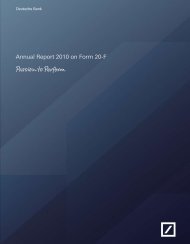entire - Deutsche Bank Annual Report 2012
entire - Deutsche Bank Annual Report 2012
entire - Deutsche Bank Annual Report 2012
You also want an ePaper? Increase the reach of your titles
YUMPU automatically turns print PDFs into web optimized ePapers that Google loves.
<strong>Deutsche</strong> <strong>Bank</strong> 05 – Supplementary Information 406<br />
Financial <strong>Report</strong> 2010 Glossary<br />
R<br />
Rating<br />
The result of the objective assessment of<br />
the future economic situation – namely the<br />
default probability – of counterparties based<br />
on present characteristics and assumptions.<br />
The methodology for the rating assignment<br />
strongly depends on the customer type and<br />
the available data. A broad range of methodologies<br />
for the assessment of the credit<br />
risk is applied, such as expert systems and<br />
econometric approaches.<br />
Regulatory Capital<br />
Capital recognized for regulatory purposes<br />
according to the Basel Capital Adequacy<br />
Accord of 2004 for banks. Capital according<br />
to Basel II consists of:<br />
– Tier 1 capital: primarily share capital,<br />
reserves and certain trust preferred securities,<br />
– Tier 2 capital: primarily participatory capital,<br />
cumulative preference shares, longterm<br />
subordinated debt and unrealized<br />
gains on listed securities,<br />
– Tier 3 capital: mainly short-term subordinated<br />
debt and excess Tier 2 capital.<br />
Tier 2 capital is limited to 100 % of Tier 1<br />
capital and the amount of long-term subordinated<br />
debt that can be recognized as<br />
Tier 2 capital is limited to 50 % of Tier 1<br />
capital.<br />
Regulatory Capital Ratio<br />
Key figure for banks expressed as a percentage<br />
ratio of regulatory capital to the<br />
overall regulatory risk position, comprised of<br />
credit, market and operational risks<br />
according to Basel II. The minimum capital<br />
ratio to be complied with is 8 %. At least half<br />
of the regulatory capital principally has to be<br />
Tier 1 capital which leads to a minimum<br />
Tier 1 ratio of 4 %.<br />
Regulatory Trading Book and <strong>Bank</strong>ing Book<br />
The regulatory trading book is defined in<br />
Section 1a of the German <strong>Bank</strong>ing Act. It<br />
consists of financial instruments and commodities<br />
held with trading intent or held for<br />
the purpose of hedging the market risk of<br />
other trading book positions; repurchase<br />
transactions, lending transactions and similar<br />
transactions which relate to trading book<br />
positions; name-to-follow transactions; and<br />
receivables directly related to trading book<br />
positions. Financial instruments and commodities<br />
assigned to the trading book must<br />
be tradable or able to be hedged. The regulatory<br />
banking book comprises all positions<br />
that are not assigned to the trading book.<br />
Repo (Repurchase Agreement)<br />
An agreement to repurchase securities sold<br />
(genuine repurchase agreement where the<br />
asset remains the seller’s property). From<br />
the buyer’s viewpoint, the transaction is a<br />
reverse repo.<br />
Reputational Risk<br />
Risk that publicity concerning a transaction,<br />
counterparty or business practice involving<br />
a client will negatively impact the public’s<br />
trust in the Group.<br />
Residential Mortgage-backed Securities<br />
(RMBS)<br />
Mortgage-backed securities (MBS), which<br />
are backed by residential mortgage loans.<br />
Return on Average<br />
Total Shareholders’ Equity (RoE)<br />
In general: ratio showing the income situation<br />
of a company, setting profit (net income)<br />
in relation to capital employed. Here: net<br />
income as a percentage of average capital<br />
employed over the year.<br />
Risk-weighted Assets (RWA)<br />
Risk-weighted assets are positions that<br />
carry credit, market and/or operational<br />
risk, weighted according to regulatory<br />
requirements. RWAs are regulatory capital<br />
requirements multiplied by 12.5, or in other<br />
words, capital requirements equal 8 % of<br />
RWA.<br />
S<br />
Sarbanes-Oxley Act (SOx)<br />
U.S. capital market law passed in 2002 to<br />
strengthen corporate governance and<br />
restore investor confidence in response to a<br />
number of major corporate and accounting<br />
scandals. Legislation establishes new or<br />
enhanced standards ranging from additional<br />
Corporate Board responsibilities to criminal<br />
penalties for all companies that have listed<br />
their shares on a U.S. stock exchange.<br />
Securitization<br />
Creation of tradable securities from loan<br />
claims, deposit positions (i.e. future cash<br />
flows) and ownership rights in the wider<br />
sense. Examples of securitized rights are<br />
asset-backed securities and mortgagebacked<br />
securities (MBS). Rights are often<br />
evidenced through so-called SPEs (special<br />
purpose entities), companies whose sole<br />
purpose is to issue these securities and<br />
whose assets are the ownership interests in<br />
the company.<br />
Seed Investments<br />
Money used for initial research and/or<br />
operation of an investment fund.<br />
Segment Information<br />
Disclosure of a company’s assets, income<br />
and other information, broken down by activity<br />
(division) and geographical area (region).<br />
Shareholder Value<br />
Management concept that focuses strategic<br />
and operational decision-making on the<br />
steady growth of a company’s value. The<br />
guiding principle is that only returns above<br />
the cost of capital add value for shareholders.<br />
Step Acquisition<br />
In a step acquisition, an acquirer obtains<br />
control of an acquiree in which it held an<br />
equity interest immediately before the<br />
acquisition date (also known as business<br />
combination achieved in stages). In these<br />
transactions, the acquirer remeasures its<br />
previously held equity interest at fair value<br />
and recognizes the resulting gain or loss, if<br />
any, in the income statement.
















